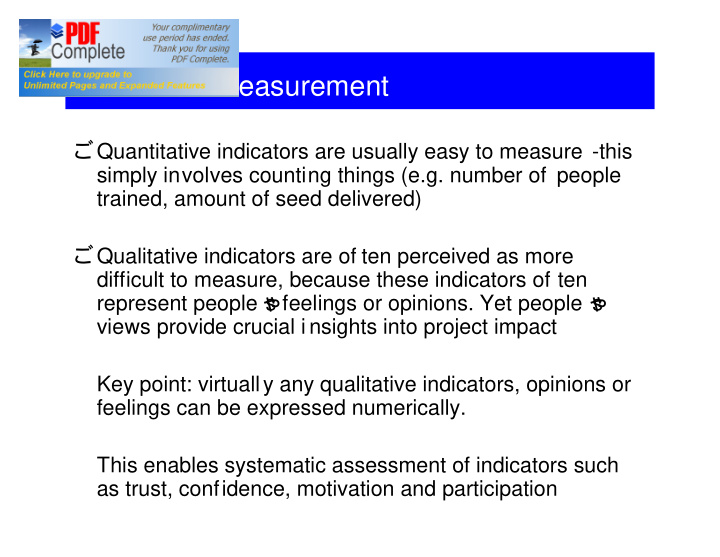



Session 4: Measurement � Quantitative indicators are usually easy to measure -this simply involves counting things (e.g. number of people trained, amount of seed delivered) � Qualitative indicators are of ten perceived as more difficult to measure, because these indicators of ten represent people � s feelings or opinions. Yet people � s views provide crucial i nsights into project impact Key point: virtually any qualitative indicators, opinions or feelings can be expressed numerically. This enables systematic assessment of indicators such as trust, confidence, motivation and participation
Overview of Participatory Methods CARE � S Ethiopia Pastoral Program Enhancing the resilience and self -reliance of Participatory methods pastoralist communities to drought related shocks and stress � Interviewing methods � Visualization methods � Ranking & scoring
Methods in PIA Ranking & scoring Before � & � After � Pair-wise ranking & scoring (matrix & proportional pilling)
� All methods are supported by secondary literatures & direct observations � The result of one method are compared with the results of one/more methods � The 3 pillars of PIA are: 1) Sharing, 2) Attitude & behavior and 3) tools � Impact assessment involves a) understanding, b) analysis and c) explaining � Respect is the key to the success of this process (PIA) � Be aware of the non-verbal communication (dress code, body posture & behavior) � Your behavior says a lot than what you are saying � Avoid biases & leading questions � Look beyond the box and check for consistency in information
Interview Techniques & Team Composition � Semi-structured Interviews (SSI) � Structured Interviews � Informal Interviews � Triangulate your findings through the following Visualization � mapping, venn & flow diagrams, transects, secondary d ata Ranking & scoring Direct observation
E.g. 1 � A community health project wanted to look at people's participation in the project. They decided to focus on five aspects of project implementation, in which people might participate. � Need assessment � Leadership � Resources mobilization � Project organization � Management (decision-making)
Pair-wise ranking CAHWs Government Other CAHW = Gover = Other =
Example: measuring local perceptions of changing livestock disease patterns Relative incidence of cattle disease before a CAHW project and � now � , Western Upper Nile, South Sudan Method: proportional pill ing with 6 community groups.
Before Now Before and after scoring of cattle diseases, CAHW project, Southern Sudan Gieng Liei Rut Doop Dat Duny Yieth Ping What information could you use to cross -check the findings ? � Did the project provided medicines or vaccines f or the disease called � Gieng � ? � Did the project supply suff icient volumes of vaccine or medicine to cause such a dramatic reduction in this disease?
Recommend
More recommend